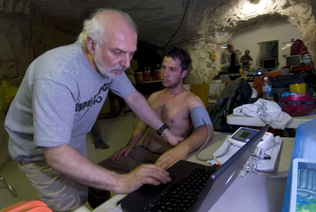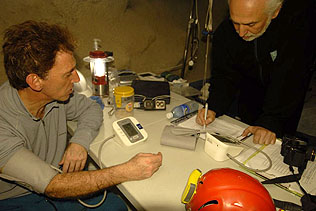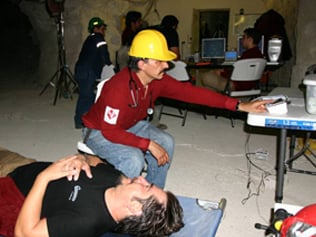|
Giusseppe Giovine checking Alejandro Macías’s |
Medical station at the base camp. Dr. Giuseppe |
A fundamental part of the Naica project was to implement the safety measures outlined by Industrias Peñoles, but it was essential to establish our own safety rules, since the experience of - La Venta Exploring Team - contrasted with the total lack of experience of the- film crew-. Because of the extremely risky conditions prevailing C/Producciones focused in providing information, support and medical attention to the photo and film crew. The nature and intensity of the job required daily work sessions lasting from two to three weeks. |
| We seriously undertook to follow-up the speleologists and photographers, men and women between 25 and 60 years of age, constantly exposed to extreme heat. The time remaining in the cave varied, but it could not be more than two hours per day according to our safety rules, adding the partial time of up to 10 to 15 cave entries per day. A working day in the external camp could be of up to 12 hours or more. At times the crew worked all night to monitor the correct functioning of the instruments. These working conditions placed the participants at constant risk since they limit physical resistance. |
ue to the above, under the coordination of S&F, documents establishing the norms to regulate the work within the cave, and the measures to be taken in case of emergency were prepared, with the participation of Dr. Germán Gonzalez, Giuseppe Giovinne and Dr. Haffid Eleasin Sánchez. |
|
|
Germán González checking Manuel Gálvez after |
As a result of the follow-up and monitoring of participants performing tasks of intense activity in the Cave of Crystals, a Medical Research Project developed. “CARDIOVASCULAR AND METABOLIC EFFECTS DUE TO EXHAUSTION Project’s proposal: • To evaluate cardiovascular and pulmonary effects in relation to the time of exposure to heat and humidity, as well as the effects of accumulated exposure during the duration of the expedition on muscular mass, and hepatic and renal functions. • To compare the protection afforded by the thermal suit to heat exposure, on cardiovascular and pulmonary effects and on muscular mass and hepatic and renal functions. • To observe signs of illness caused by exposure to heat, under extreme conditions of temperature at 50ªC and 100% humidity, in the Naica Project personnel. • Create conscience of self-care and risk prevention, insisting in those conditions that favor dehydration and hydro-electrolytic imbalance. • To establish minimum rules to enter the cave, and evaluate the protection offered by the ice-lined thermal suit and the cold air atomizer, to be able to remain longer in the cave. Stages of development: The preliminary protocol was prepared, April-May 2007 – Pilot test with the production team and five speleologists, May 2007 – Physical survey of the Cueva de los Cristales, May 2007 – Evaluation of the pilot test results, July-August 2007 – Preparing the final protocol, August- September 2007 – Drawing up safety regulations October, 2007 – Training in the service of pneumology, October 2007 to perform spirometrics – To integrate the medical team and work crew: spirometer, oxymeter, scale, etc., October-November 2007 – To draw-up the clinical history of the production team and take electrocardiograms and basal spirometers, November 2007 – Physical conditioning of the production team, October-November 2007 – Intensive Research period, 1:21 December 2007 • application of initial questionnaire every 5 days • physical exploration and taking vital signs daily, • taking electrocardiograms and spirometers every 5 days • measuring the urinary density with a reactive tape every 5 days • taking of laboratory samples at the end.
Dr. Germán González
|




